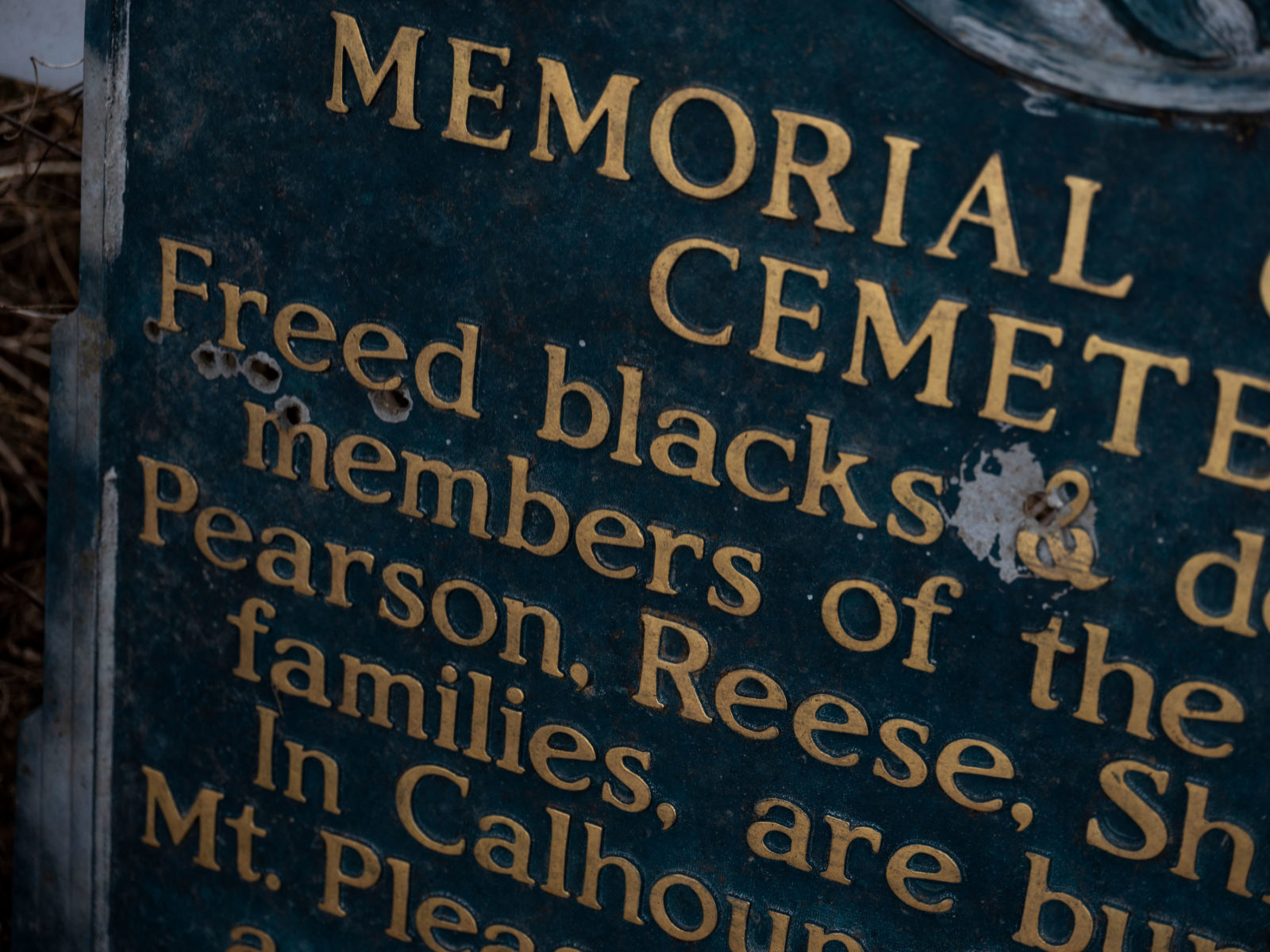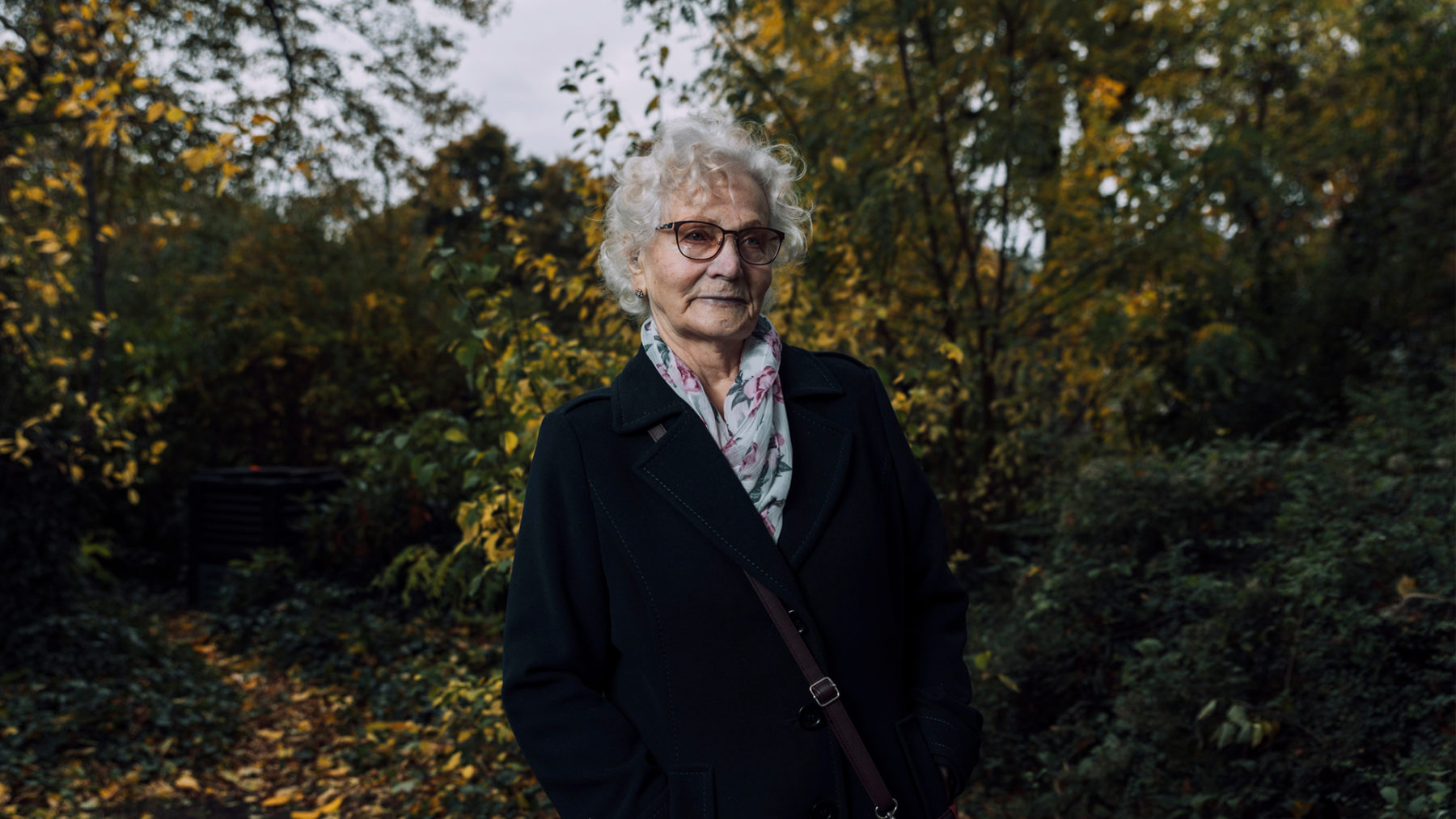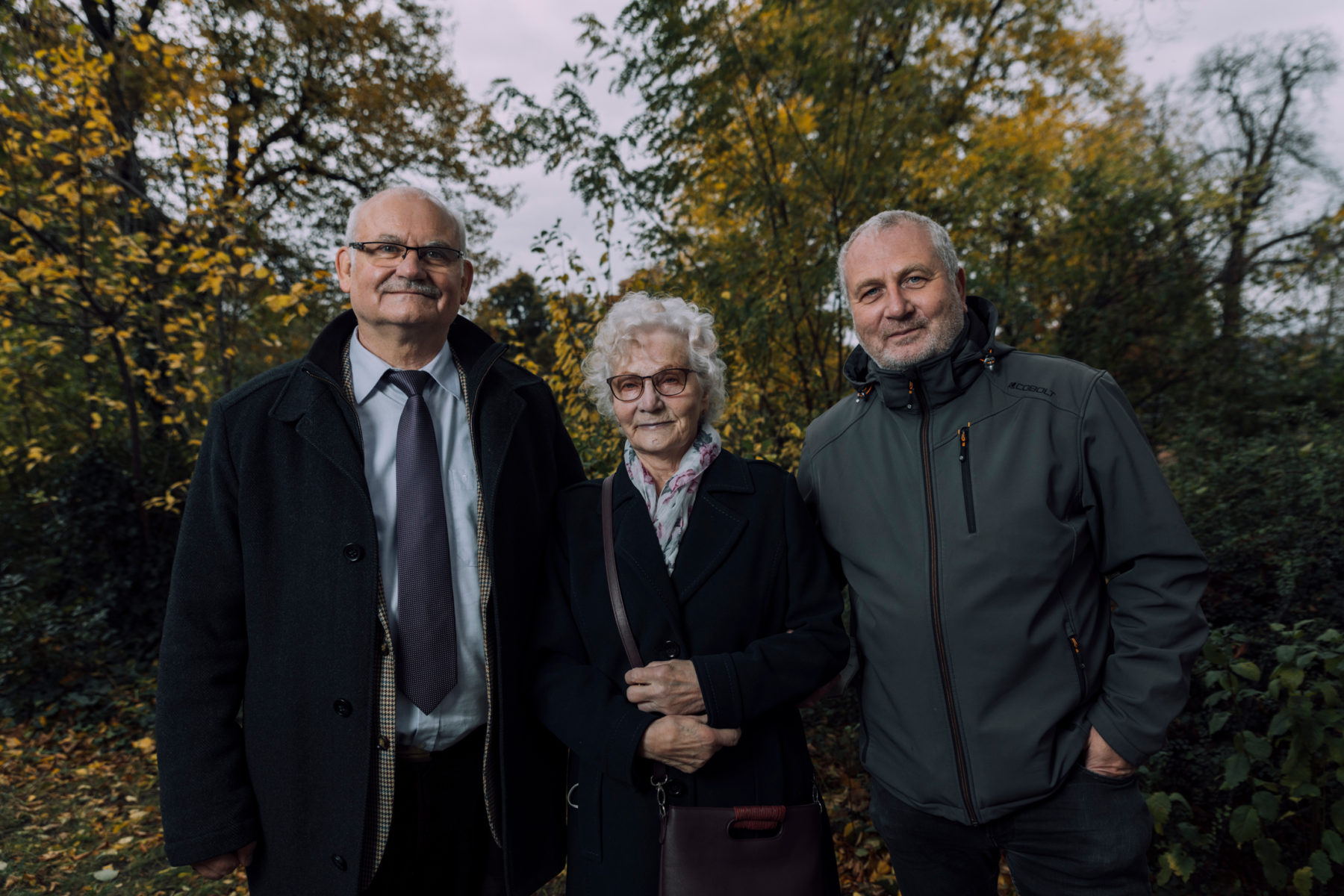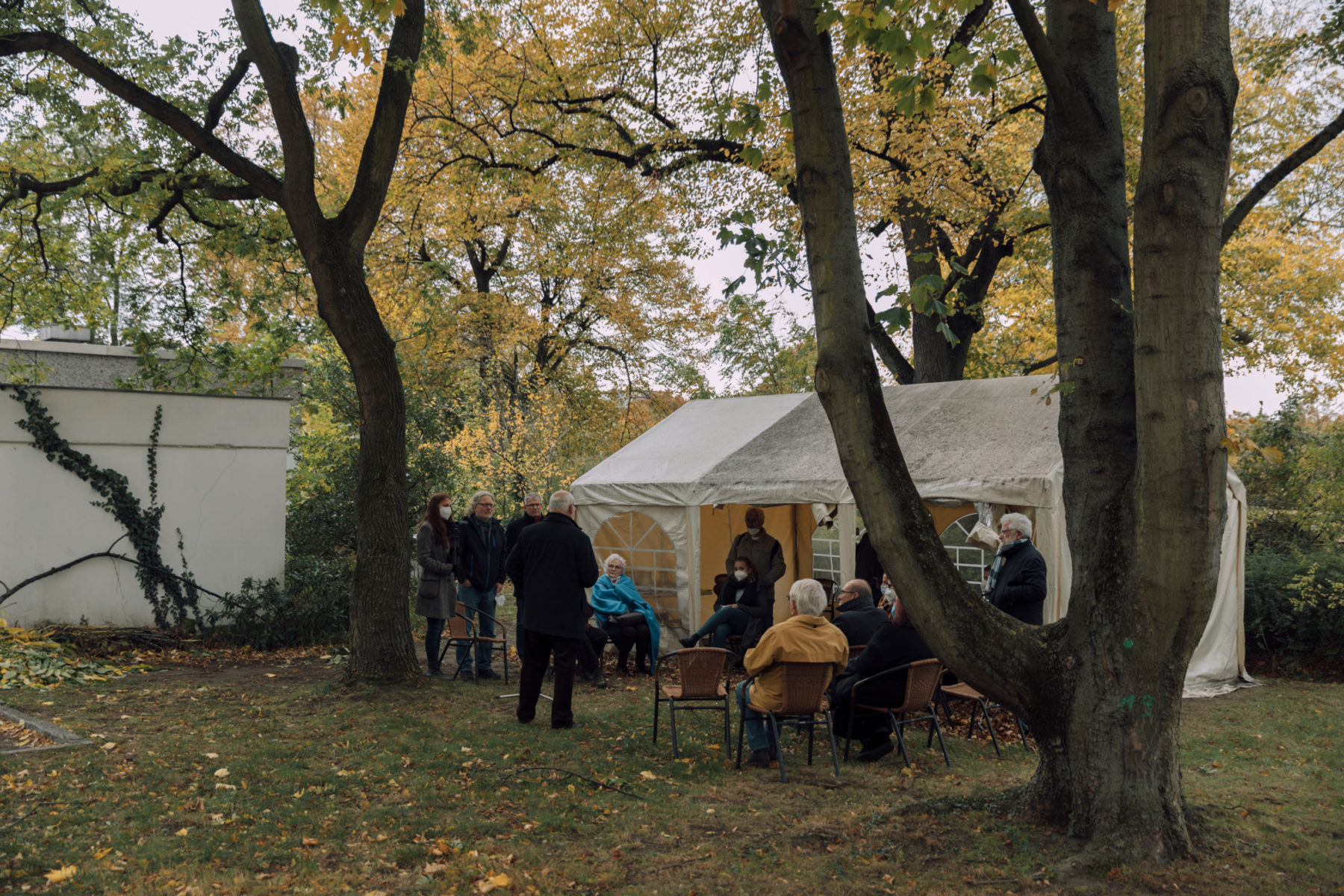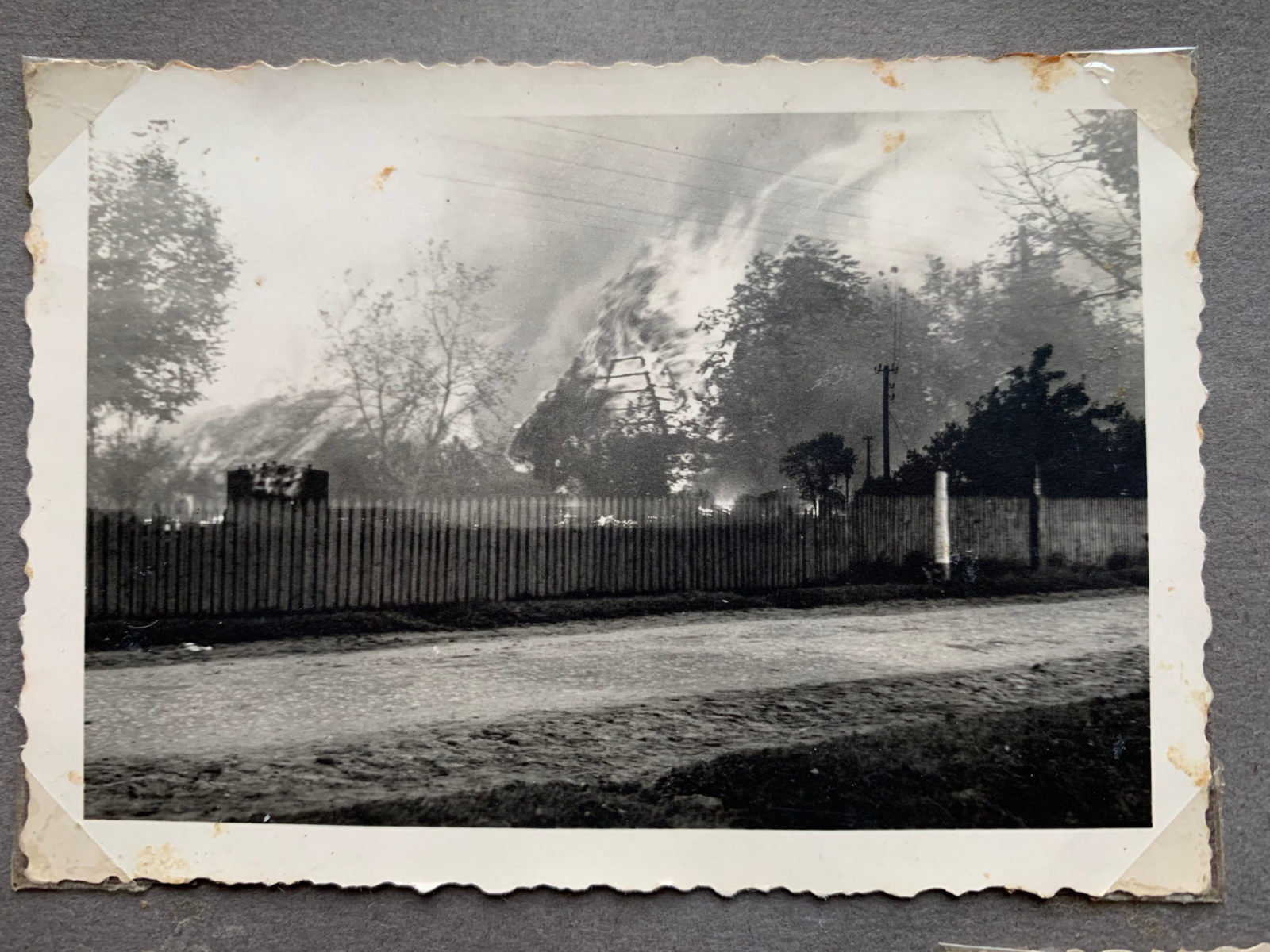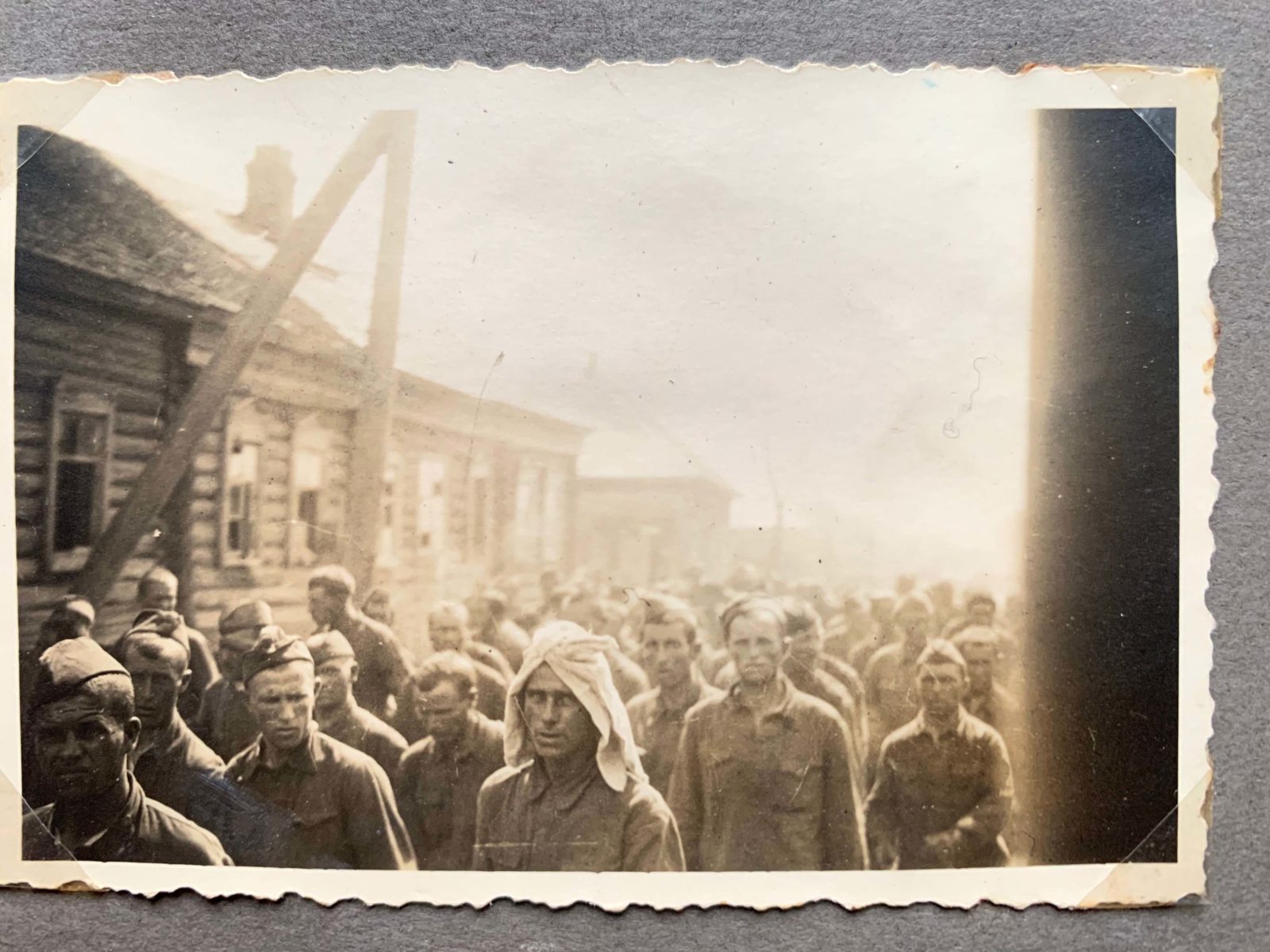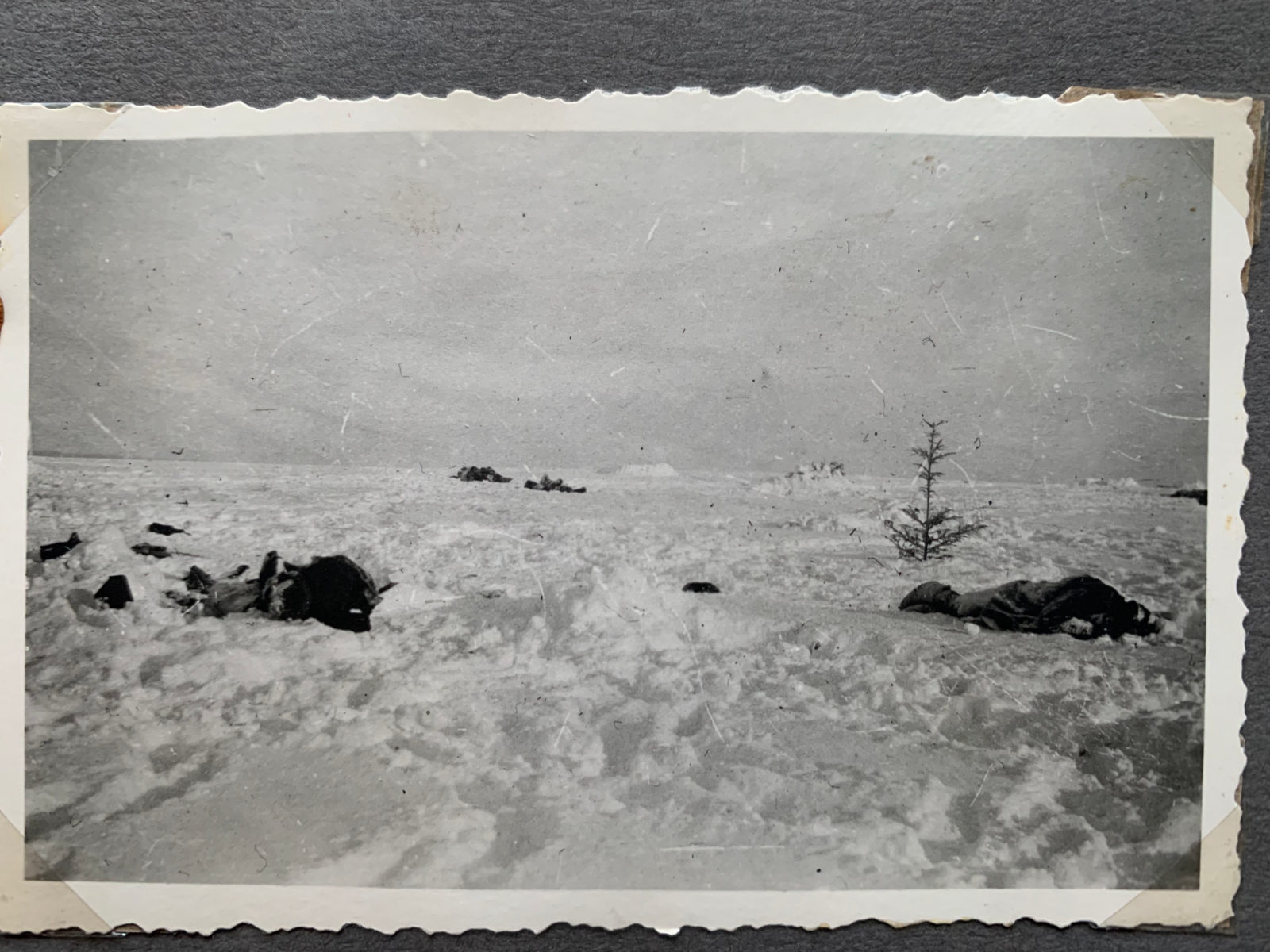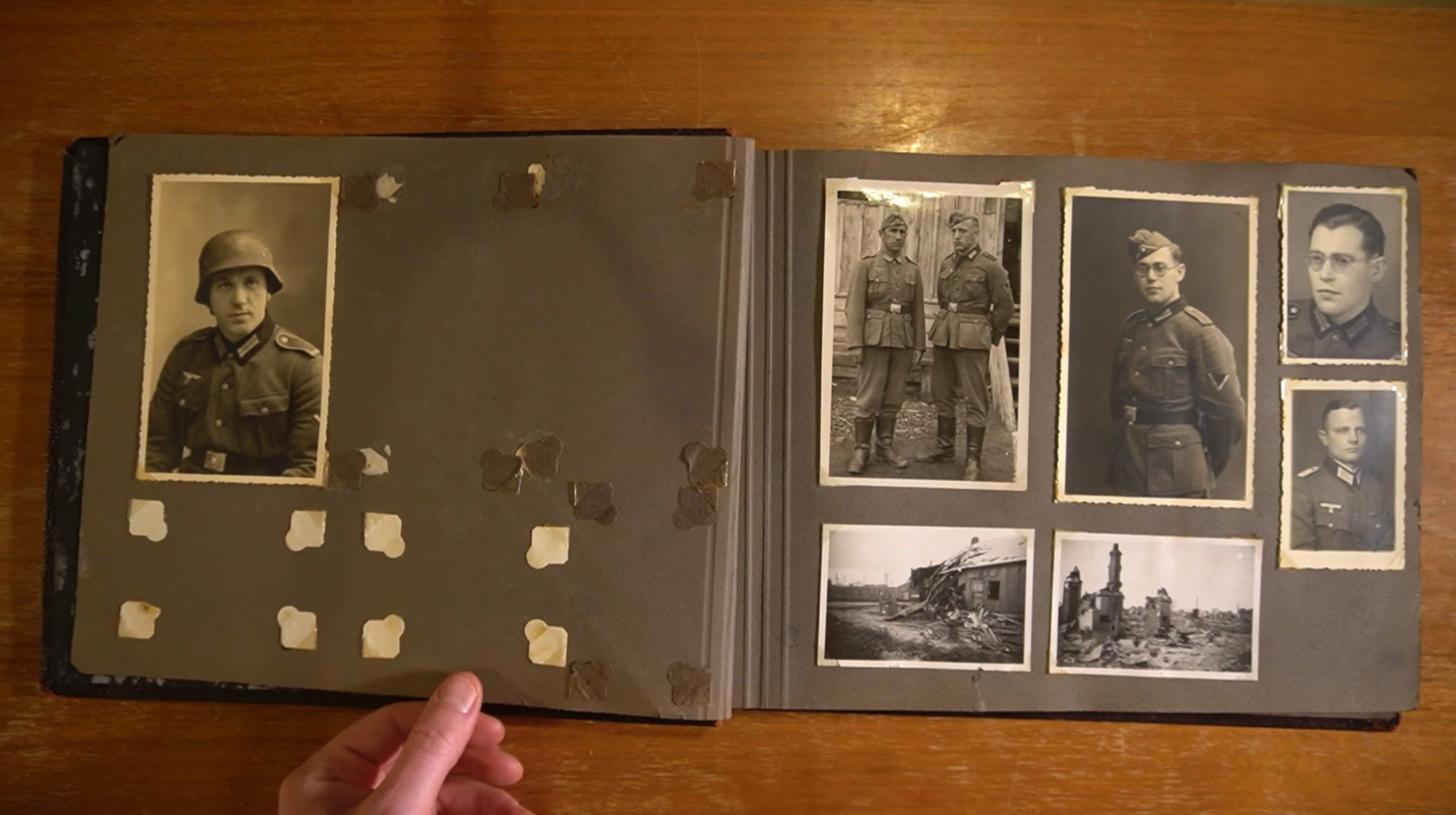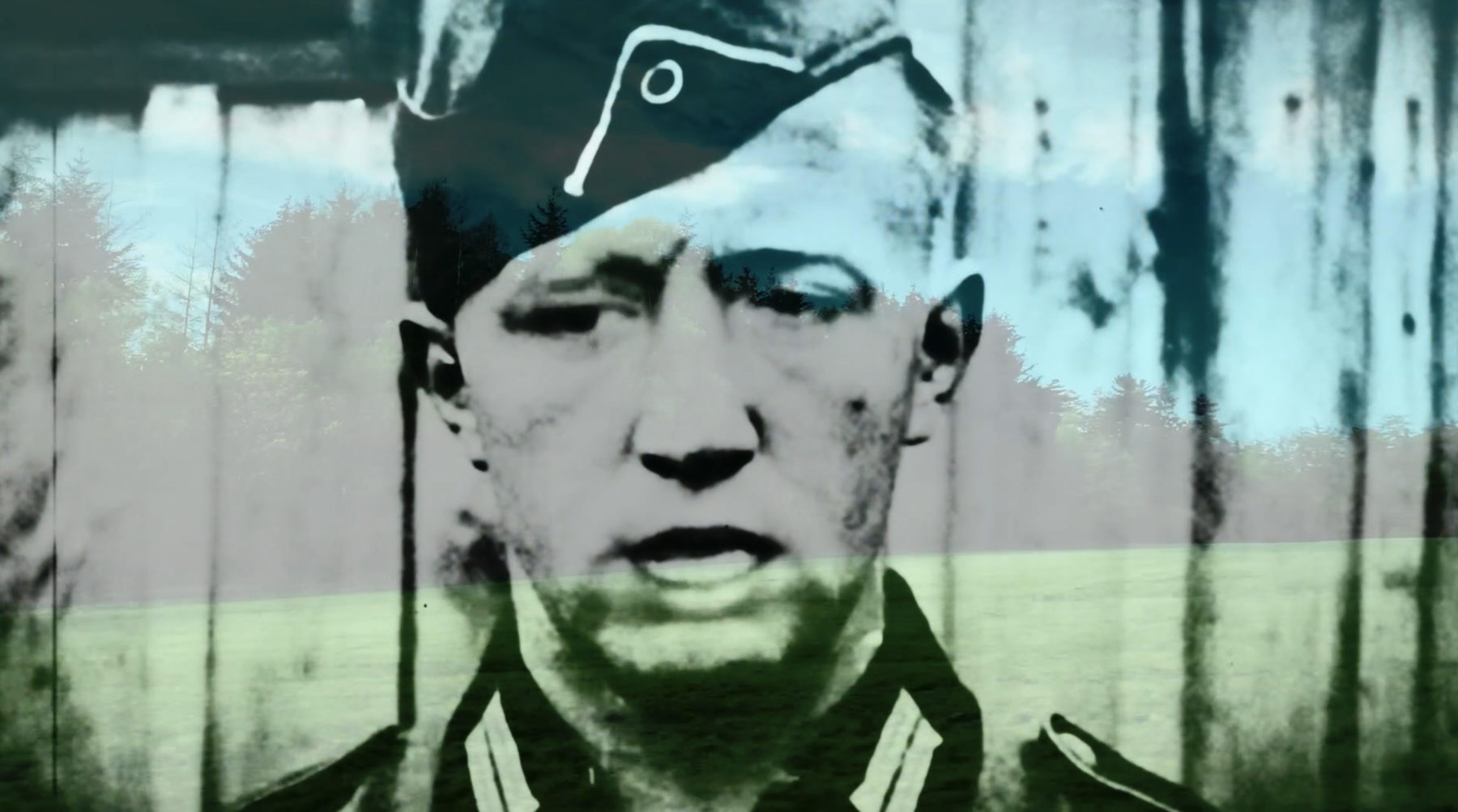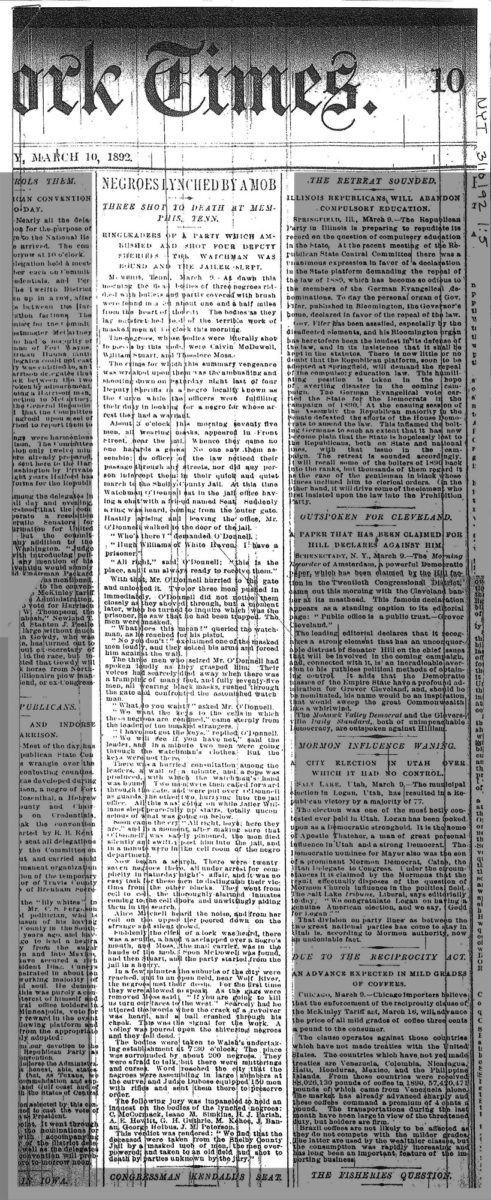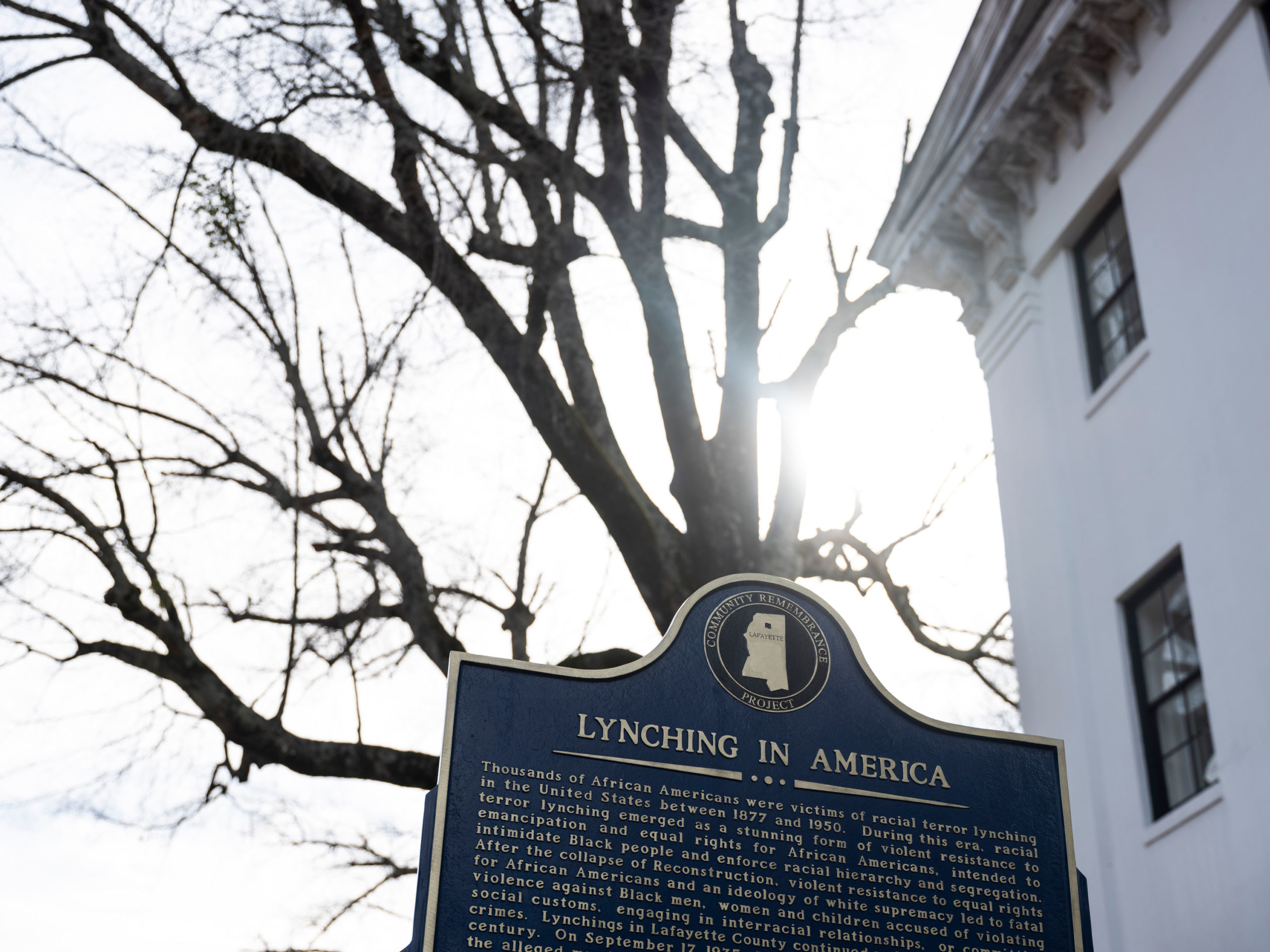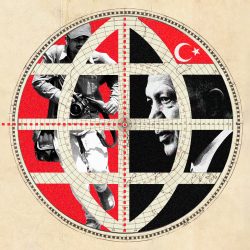
Brad Vest
Germany’s historical reckoning is a warning for the US
- Photography by Brad Vest
Antonio Tarrell would never have known about the lynching if he hadn’t come across that one Facebook post. His family didn’t know about it either. He didn’t learn about it in school or in the small town he grew up in. It was a suppressed chapter of Mississippi history, hidden out in the woods.
Otherwise, the 47-year-old knew plenty about his roots. He grew up steeped in his family’s stories, and fears, about Mississippi. He knew his ancestors were enslaved on a sprawling plantation about twenty miles outside of the picturesque town where William Faulkner grew up, and some of them were buried in a nearby cemetery lined with weathered headstones. He knew the slave owners of the plantation were Irish, and he knew, through a DNA test, that he had some Irish heritage, too. And he knew, from a story passed down from his grandmother, that a white man thrust a double-barrel gun in his great-grandfather’s mouth and stole his land.
He just never knew about the lynching. Until he saw the photo.
The first time Tarrell caught a glimpse of the plantation, a chill came over his body. “You could feel it,” he recalled, winding down a lonely road in Mississippi. It was a stormy day in mid-December, and we were driving to the property where his ancestors were enslaved. The sky was dark and moody, and tall weeds shivered in the wind. The weight of it all hung in the air. “It’s heavy,” he told me, pulling up to a white house overlooking an open field.
Tarrell led me to a tangle of brush at the edge of the house’s lawn. He crouched down, scanning the earth for a budding rosemary plant. When he found it, he gave me a nod. “Here’s where we did it,” he said, pointing to the dirt. We were looking at the de-facto grave of William Steen, whose lynching was swallowed up by more than a century of silence.
Growing up, Tarrell knew nothing about Steen’s death, or that they were related. Nobody in his family did. Like many lynchings of that era, there are few public accounts of what happened. What we do know comes from two short newspaper articles published in the days after the killing: Steen, a former employee at a railroad shop, was hung by a mob on July 30, 1893, near Paris, Mississippi, about 30 minutes down the road from the University of Mississippi in Oxford. “He boasted of being criminally intimate with an estimable white woman,” explained an article published the day after the killing. A second article described Steen as a “negro of ill-repute.”
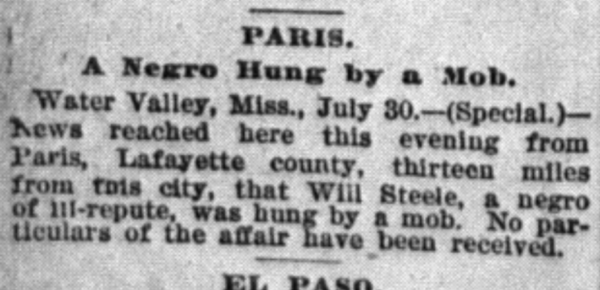

It’s unclear if Steen was buried, or when the memory of his death began to fade. By the time Tarrell learned about it, nearly 130 years had passed. “I feel like I’m the voice for the dead,” he said.
Tarrell found out about two years ago while scrolling through his Facebook newsfeed. That’s when he came across a picture from America’s national lynching memorial of a rust-colored rectangular column inscribed with the names of seven lynching victims from Lafayette County, Mississippi, where Tarrell lived. He clicked on the photo and glanced at the names. When he saw William Steen, he paused. He knew he was related to a line of Steens from the same part of Mississippi. Could he have ties to this one?
Tarrell messaged the author of the Facebook post. She told him the lynching took place near the plantation where his family was enslaved, and the general area where they later lived. Tarrell reached out to a few family genealogy experts, and they began investigating the connection. Eventually, they concluded that Steen, the lynching victim, was the brother or cousin of Tarrell’s great-great-great grandfather.
Tarrell shared his findings with the members of the racial justice group documenting local lynchings, and they decided to arrange a long-overdue memorial for Steen in May 2021. Tarrell chose the property of the former plantation because of its proximity to his family’s ancestral cemetery. About 60 people showed up, including many of Tarrell’s relatives.

At the ceremony, Tarrell’s teenage son filled a glass jar bearing Steen’s name and the date of his lynching with fistfuls of soil from the ground where his ancestors were enslaved. 
The group planted a rosemary tree to mark the location.
“Some of my family members were crying, thankful that I was able to share that experience with them and to honor William Steen,” he said.
Tarrell’s family members, like him, had only learned about Steen’s lynching for the first time.
The realization bowled Tarrell over. He couldn’t believe that if he hadn’t checked Facebook, the whole story would have been wiped from his family’s memory. But he also didn’t think any of it would have been particularly surprising to people in Mississippi. The first time Tarrell drove to the former plantation, about a decade ago, a white friend told him to call her in two hours or she would alert the local chief of police. “They’re still active out there,” she warned. “The Klan.”
When I traveled with Tarrell to the site of the former plantation and Steen memorial, about thirty minutes after we arrived, Tarrell led me to a tall cluster of weeds along the side of the road. He wanted to show me a historical marker identifying the nearby cemetery as a burial site for Black families after the Civil War. “Somebody shot bullets in it,” he said. But as Tarrell sifted through the brush, he realized the historical marker was nowhere to be found. He turned to me, incredulous.
“Somebody took it,” he said.
Steen was one of about 6,500 Black Americans lynched in a cluster of Southern states between 1877 and 1950. Mississippi was home to more lynchings than any other state in the country. Its legacy of violence stretches right up to the modern day — haunting family histories, memory, and behavior. When Tarrell’s grandmother learned he was quietly courting a white girl in high school, in the 1990s, she had an immediate, angry response: You could get lynched. “Those goddamn white folks gonna hang you,” she fumed. She wanted to protect him from the Mississippi she knew.

Lynchings weren’t hidden. They were often a deliberately public spectacle, drawing throngs of cheery white spectators who posed, smiling, in photos in front of the brutalized bodies, or brought home pieces of the victims as mementos. Like the Black man burned at the stake in 1899, dismembered, and sliced “into pieces, bones crushed into small bits and disposed of as souvenirs,” according to a newspaper account from the time. To deepen the terror, mobs would occasionally deposit victims’ mutilated bodies in Black neighborhoods and communities. In 1917, thousands sung Confederate hymns as they watched a Black man burned alive and decapitated in Tennessee. His severed head was then thrown onto Memphis’ Beale Street, the epicenter of the city’s Black business district. Such public, brutal displays of violence were intended to send an unambiguous message to Black Americans: Stay in your place, or else.
The federal government tried, and failed, to step in. By the 1950s, nearly 200 anti-lynching bills were introduced in Congress, but not one of them passed; they were often thwarted by Southern white Senators. The consequences of inaction were deep and long-lasting. “More than the poll tax, the grandfather clause, and Jim Crow segregation, lynching and the threat of lynching helped regulate and restrict all aspects of Black advancement, independence, and citizenship in many small towns for half a century,” wrote Sherrilyn Ifill, the president and director-counsel of the NAACP Legal Defense Fund in “On the Courthouse Lawn,” an examination of lynchings in the 1900s. Even today, research has found that the Southern counties with the highest rates of lynching also have the lowest rates of Black voter registration.
Lynchings were so traumatizing that some witnesses stayed silent about them their entire lives.
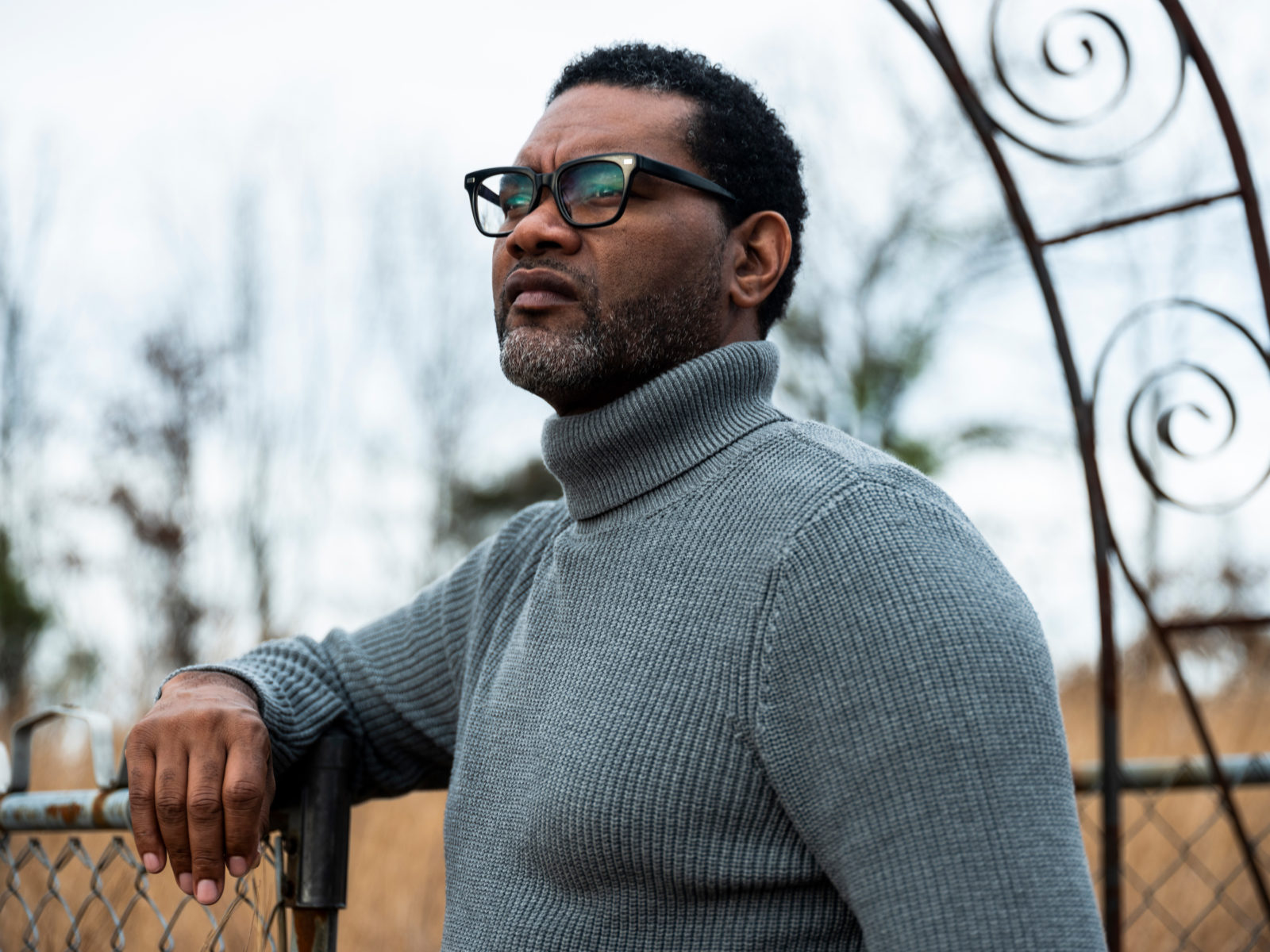
Tarrell belongs to a movement popping up from Arkansas to Alabama attempting to awaken the country’s memory of these dormant histories, by marking the landscape with echoes of its violent past.
Despite thousands of documented lynchings, America’s first national lynching memorial did not open until 2018 – in Alabama, where an estimated 300 Black Americans were lynched from the late 1800s to the mid 1900s and Confederate Memorial Day is still an official state holiday.
After more than a century of failed attempts, the U.S. Senate — for so long an obstacle to federal anti-lynching legislation — finally approved a bill designating lynching as a hate crime punishable up to 30 years in prison. On March 29, 2022, President Biden signed the historic bill into law. Still, as the country tiptoes toward a truth, it remains disabled by the long tail of its silence.
Silence distorts memory in various ways. It can happen when a nation, collectively, refuses to engage with the realities of its past, opening up space for revisionist histories and feel good counter-narratives that gloss over the horrors of the past. Sometimes national silence is summoned as an act of avoidance; other times, to serve a political or ideological agenda.
But silence also flows from the collective to the individual. A society can forget on a mass scale, not when the government imposes amnesia as a political project, but when people refuse to look within — to dig into the messy and complex family biographies that turn memory into a landmine, and forgetting into a psychological salve. Even the country held up as the global exemplar of historical reconciliation, Germany, is still haunted by the ghosts of family memory and perpetrator guilt.
When it comes to facing the past, Germany is often praised as the poster child of success. The country even has a specific term for the painful process of reconciliation that unfolded in the decades after the Holocaust: Vergangenheitsaufarbeitung.
The word, which has no equivalent in English, means “working off of the past.” It is occasionally used interchangeably with the English phrase “memory culture” to describe Germany’s wide-ranging and layered approach to Holocaust memory, which includes literature, education, art, popular culture, and physical memorials. I first learned the term in an email with a German historian while preparing to travel to Berlin. I began to use it almost obsessively when I arrived, and not just because there was absolutely no way I could pronounce Vergangenheitsaufarbeitung. The idea of a collective, nationally sanctioned culture of remembrance intrigued me, maybe because it felt so impossible to imagine in America, a country perpetually at war with itself over how to remember the past (see: Critical Race Theory).
Vergangenheitsaufarbeitung did not unfold easily or quickly, however. Most Germans were not particularly eager to face up to the horrors of the Holocaust after the war. Although the Allies imposed a denazification program in West Germany, its government was still chock full of former members of the Reich a decade after the war; in 1957, nearly 80% of senior officials in West Germany’s Justice Ministry were former Nazis.
Meanwhile, narratives of victimhood were pervasive across Germany. There was a widespread feeling among Germans that they suffered tremendously during the war, and were its real victims. In the late 1960s, a wave of youth activism began to challenge some of these attitudes, as a younger generation moved to confront the country — and their parents — over its Nazi past.
A decade later, the release of the 1978 American television miniseries “Holocaust” had an enormous cultural impact across Germany. Nearly 20 million West Germans tuned in to watch the show about a fictional Jewish family. It brought many viewers into the lives and stories of victims for the first time, and is widely seen as catalyzing the country’s reckoning.

In the 1990s, another crucial shift occurred when Germany reunified and memory culture became absorbed by the state: “In order to become accepted globally, a lot of money was put into mastering one’s past, putting up commemoration sites and museums,” Stefanie Schüler-Springorum, a German historian and the director of Berlin’s Center for Research on Antisemitism, told me. Public memorials and museums later popped up across the country, including the famous Holocaust memorial in the heart of Berlin.
Since then, Germany’s atonement has been invoked as a global success story: an example of a country that bravely dealt with its past and became a model for other countries’ long overdue historical reckonings.
In America, scholars and journalists have increasingly begun to talk about Germany’s process in conversations about race and reconciliation, poring over Vergangenheitsaufarbeitung for clues about how the U.S. can meaningfully confront its history of slavery and racial violence. Seen from an American perspective, Germany is often portrayed as the wise and capable professor of remembrance; the U.S its difficult student.
The Atlanta-raised, Berlin-based scholar Susan Neiman wrote an influential book about what the U.S. can learn from Vergangenheitsaufarbeitung, inspiring an outpouring of articles in magazines and newspapers dissecting Germany’s reckoning in an American context. One of the most recognizable figures in America’s lynching memorial movement, the pioneering American civil rights attorney Bryan Stevenson, has often contrasted the two countries’ versions of remembrance, comparing America’s South “littered with the iconography of the Confederacy” to Berlin, awash in Holocaust memorials. Stevenson, the founder of America’s first national lynching memorial, said his initiative drew inspiration from Germany’s landscape of Holocaust memory and homages to the victims of Hitler’s killing machine.
“When you go to Berlin, you can’t go 200 meters without seeing markers and stones that have been placed next to the homes of families that were abducted during the Holocaust,” Stevenson remarked. “There are no Adolf Hitler statues in Germany.”

On a rainy morning in October, Gisela Martin placed a rose on top of a freshly polished gold stone. She stood outside of her mother’s last residence, an apartment building in a busy Berlin neighborhood, before she was murdered by the Nazis in the late 1930s. Martin was joined by her nephew, son, and a handful of locals, to lay a memorial stone in the sidewalk in front of the building. The brass block, roughly the size of a CD case, is inscribed with Martin’s mother’s name, birthday, and the dates she was deported and murdered by the Nazis. Rain and wind pelted the group, and Martin — petite, in a dark peacoat — stood quietly next to her nephew as volunteers placed the stone in the ground. It was jarring for Martin to see the truth of her mother’s murder, a long-guarded family secret, on the pavement for anyone who walked past it to see.
There are more than 75,000 of these memorial stones, called Stolpersteine, across Europe, making the project the largest decentralized Holocaust memorial in the world.
“What really works are these little stones,” Michael Naumann, Germany’s Culture of Secretary from 1998 to 2000 as the government finalized Berlin’s Holocaust memorial, told me: “Because these are individual names. The only way you can actually teach the Holocaust is to grab you by your heart.”
In Berlin alone, the streets are studded with roughly 8,500 gold squares, which are impossible to miss once they’ve been pointed out. They glisten off some of the busiest avenues in the city and quiet side streets, in front of apartments, restaurants, cafes, and commercial buildings. For people who choose to read what they say, the individual stories within each stone force the kind of intimate, and personal, confrontation with Germany’s past that can get lost in the larger and more abstract memorials.
Gisela Martin’s mother was the casualty of a little-known Nazi extermination program called Aktion T4, which claimed the lives of about 300,000 people with disabilities between 1939 and 1945. The “euthanasia campaign,” as the Nazis called it, sought out to eradicate German society of people with mental and physical impairments. The victims were among the first targets of the Nazi regime, described as the Holocaust’s “trial run.” The medical establishment was involved in every step of the murder campaign, beginning with identifying victims and ending with overseeing and carrying out the killings. By 1941, the T4 program had exterminated some 70,000 people in death centers across Germany by lethal injection and gassing.
Gisela Martin’s mother, Hedwig Daum, was forced from her home and taken to a psychiatric hospital in December 1937, where she was diagnosed with schizophrenia (Daum’s relatives are skeptical of the diagnosis, but say she was under a considerable amount of stress at the time and may have had a nervous breakdown). The following year, officials involved with the program forcibly sterilized her — another feature of the T4 program — and brought her to a psychiatric hospital. She was released, and then shortly thereafter brought back to a psychiatric unit, where she remained imprisoned until she was murdered on May 29, 1939.

Gisela Martin at the stone-setting ceremony for her mother, Hedwig Daum, who was murderd by the Nazis in 1939. 
Gisela Martin (center) stands with her nephew, Reiner Lenz (left) and son Hans Steffen Daum (right). 
Some of the participants as well as relatives of Hedwig Daum attending a small get to-gather after planting the Stolperstein.
Martin, who is 88-years-old, was four when Daum died, and her recollections of her mother are fuzzy. Memories come in abrupt flashes: sitting on her mom’s lap while food simmered on the oven, filling the apartment with rich scents, or waving to her through the window of the psychiatric ward. But a memory of her last glimpse of her mother when the authorities came to take her away is intact. “She fought and screamed like crazy, and my sister held me in her arms,” she told me. “It was terrible.” Daum’s only wish, according to medical records later obtained by her grandson, Reiner Lenz, “was to return to her children.”
The circumstances around Daum’s death were kept for decades by only Gisela Martin, her siblings, and her father. Even among themselves, the topic remained a source of silence. “It was simply not discussed,” Martin said. The stigma and shame surrounding mental illness were so deeply rooted that Martin even kept the truth of her mother’s death from her husband. “I was afraid that if he heard about the psychiatric clinic, he would think that I’m also not right in the head if I lost my temper,” she explained. “It was kept secret.”

Martin watched solemnly as a volunteer cemented the plaque into the pavement and rinsed it off with water, leaving a gilded block nestled inside the street’s drab row of gray cobblestones. Then she crouched down, gingerly set a rose on top of the stone, and wiped away a tear. For Martin and her family, the unveiling of the marker served as a corrective against the country’s legacy of postwar amnesia about the Nazis’ crimes against the disabled. After so many decades of silence, Martin told me she was “finally ready to talk about what happened.”
The next in line to place a rose over the stone was Martin’s nephew, Reiner Lenz, who spent years researching Daum’s biography and tracking down her medical files to find the official record of her death.
“After the war, nobody talked about people like my grandmother,” he recalled. “They said, ‘forget it.’ But we shouldn’t forget. The death of my grandmother has left a gap for her children and grandchildren that has never been closed.” He believes the stone represents a quiet rejection of the country’s rising tide of right-wing nationalism. “It is intended to commemorate all the sick and denounced sick who need special protection by society,” he said. “It should be a reminder to all of us never to allow such an injustice again.”
Visiting concentration camps is not mandatory in Germany, but it is encouraged and in some schools required. One morning, I joined a class of about 20 high school students on a tour of Sachsenhausen, a Nazi death camp outside Berlin. Nobody in the class had visited a concentration camp before. They gathered quietly around their guide, a German history buff in her early thirties. She carried a black tote bag with “it’s a beautiful life without Nazis” emblazoned across the front in bubbly pink letters.
In recent years, Germany’s sites of remembrance have become a flashpoint among figures associated with the country’s far-right movement, who bemoan the country’s memory culture as a source of national shame and guilt. In 2017, a politician with the country’s main far-right party, Alternative for Germany, or AfD, assailed Berlin’s Holocaust memorial as a “monument of shame in the capital.” The party grabbed headlines the following year when a group of its constituents interrupted a tour at Sachsenhausen, questioning the existence of gas chambers, and an AfD politician called on a local mayor to ban Stolpersteine, those gold memorial stones, calling the country’s remembrance culture “a dictatorship of memory.” In their narration, the act of remembering is akin to an assault on the German identity, and nowhere are the country’s memory efforts more visible than in its memorial sites.
I decided to join the high schoolers as they toured Sachsenhausen because I wanted to understand what Vergangenheitsaufarbeitung meant to a generation that was further removed from its history than their parents or grandparents. The students passed under the famous “Arbeit Macht Frei” gate and walked into the camp, somber as the guide led them around its grounds, through the reconstructed barracks where prisoners slept and the gas chamber and execution site where tens of thousands were murdered from 1936 to 1945.
About halfway through the tour, the guide paused and withdrew two photos from her tote. She asked the class to describe them. The first was a black and white picture taken from the camp’s watchtower in 1941, looming over a neat row of prisoners with the edge of a machine gun in the frame. She explained that it was a propaganda picture of the camp used by the Nazis to convey a message of order, intimidation, and control. The second was a fuzzier snapshot of an inmate kneeling in front of a group of SS officers, including one who was laughing. This photo, she said, made the officers look cruel and arrogant, and the prisoner sympathetic. She then asked the students if they thought the picture was a propaganda photo. The class agreed that the picture portrayed the soldiers in a negative light, and therefore was not used in Hitler’s propaganda machine.
The guide told me the goal of the exercise was to show students how to distinguish between propaganda and reality — and to challenge the myth that everyday Germans didn’t know what was really going on at the time. “It’s important to show that ideas of the concentration camp were distributed very widely.”
At the end of the tour, one of the students approached me and struck up a conversation. I asked her about what she took from the guide’s photo lesson. “It was amazing to see the actual faces of the people and to see who they were because they look like normal people,” she said. “But you imagine them as monsters.” How did she talk about this history with her parents? “We don’t talk about it at all, actually,” she replied. As we chatted, a handful of her classmates migrated over, and within a minute, I was surrounded by 10.
The students told me that visiting the camp was different than reading about it. But then the conversation drifted into what it meant to learn about the Holocaust as Germans, and how they believe the rest of the world views them. “When you go to other countries, they go, ‘Oh, the German guys, they are the people who started the wars and everything. They have stereotypes,” one girl said. “We are a new generation.” Another student chimed in: “We cannot be blamed for this.” In the exchange, I saw edges of the emotions exploited by the far-right in its weaponization of memory politics.
As the two were talking, one of their peers made a face. Germans are still voting for the neo-Nazi National Democratic Party, he pointed out. Doesn’t that factor into the conversation about blame? He pointed to Sachsenhausen’s gate, visibly agitated. “Doesn’t everybody have at least a basic understanding of history?” He asked. “There’s still people who openly say they are Nazis.”
I asked the tour guide how memory is integrated into Germany’s educational system. “It is very victim-focused, which is important,” she answered. “But I think now it would be a good idea to focus more on perpetrators. Everybody agrees that the Nazis were evil. But, we have to see them as people, so we can understand that normal people are capable of doing these things.”
“It’s a wall of silence and denial, and also a wall of threat,” Dominik, a playwright, told me over Zoom from his home in western Germany, describing the process of trying to untangle his family’s past. He hoisted a black photo album in front of his screen, opening it up to a page of World War Two-era photos.
The pictures, he told me, were from his grandfather’s time in the Nazi’s armed forces, the Wehrmacht, and the album was one of just a few family remnants from that period of time (the other: a certificate affirming his grandmother’s Aryan lineage). The first time Dominik leafed through the pages a few years ago, he focused entirely on his grandfather’s face. He had a powerful urge to see if he looked unhappy. The second time he looked at the album, he noticed something startling. In the background of the photos, he saw burning villages and what appeared to be Russian prisoners of war. Somehow he completely missed the horror in the pictures when he saw them the first time around.
To Dominik, who asked to be identified by his first name because he has been targeted by neo-Nazi threats, the omission revealed a longing to see his grandfather as he wanted, not necessarily as he was. “I was looking to find proof that my grandfather was innocent,” he told me. Towns on fire and prisoners muddied that conceptualization, so “I completely kept them out of my mind.” He doesn’t believe he’s alone in that urge. “I think many people have a desire to deal with the past, but they also have a desire to say: not my parents, not my grandparents. They were fine. They helped the Jews. They were resistance fighters or victims of the Nazis.”
Dominik belongs to a cohort of Germans who are interrogating the country’s reputation as a champion of remembrance and pointing to the gaps within it as symptoms of deeper amnesia. He’s 39, with a dark sense of humor, and wary of the country’s memory worship. I mentioned some Americans’ invocation of Germany’s process as a possible model for the U.S. He chuckled. “This is like the new export product of Germany,” he told me, wryly. “After the cars, we also make this ‘great’ memory culture.”
In early November, Dominik, along with the other two members of his theater collective, screened a movie, which they will adapt into a play later this year, about how the descendants of perpetrators engage with their family histories. I attended the screening in Berlin along with a few dozen Germans who quietly sipped beverages and watched the film, which occasionally felt like a fever dream. The movie dealt with the emotional toll of silence within families and was based on interviews between the collective’s members and their parents. For each of them, confronting family narratives of the war and Nazism meant coming up against a “wall,” as Dominik told me, of shame, anger, and denial, from their parents.
The trio sought out to make the film after recognizing, as a group, that the country’s celebrated Holocaust reckoning had stopped at their own doorsteps. Dominik’s grandfather was in the army and joined the Nazi party when he was 19; the grandfathers of the other two collective members were SS officials. Growing up, their family discussions of the war focused on German — not Jewish — suffering: “about how grandfather was freezing in the Soviet Union, and he was such a victim,” Dominik explained. “These narratives are there all the time growing up. There’s no conversation about the Shoah. There’s a lot of conversation about how cruel the war was.”
Over time, Dominik grew to reject the narrative he absorbed as a child about wartime suffering, opting instead to research the parts of the story his family and so many others left out. These interrogations, and subsequent discussions with family, formed the basis of Dominik’s contribution to the collective’s film.
At first, the members’ parents were supportive of the movie, which they were told was about family memory and the war. But as the conversations grew deeper and closer to their families’ behavior in Nazi Germany, Dominik said there was a moment for each person where things took a noticeable turn. Their parents “got angry and their faces changed and they started insulting us.” For Dominik, that happened after he asked his father if he knew the history of the shop where his grandfather worked, which had been run by a Jewish family until the Nazis expropriated it. “He was like, ‘OK, now I want to know, what is this project actually about? Do you want to play police and say your family is all Nazis?’” Dominik recalled. “Then, he lost himself in the worst antisemitism I’ve ever heard in my family.”
Dominik said he was shocked and disgusted by his father’s antisemitic screed. But it also revealed to him an internal conflict. Even though he was furious, something unexpected came up: “I had the feeling that I must protect him,” he explained.
“From what?” I asked.
“From the shame I feel. He exposed himself. And it is him, not me, that I want to protect.”
I traveled to Germany to try to better understand the lessons of Vergangenheitsaufarbeitung and to unpack the narrative that I had consumed in America about Germany as a champion of memory. But during my reporting, I kept coming up against a particular strain of silence that I couldn’t move past, and I wondered if I had been thinking about the reckoning in the wrong way. Maybe the story was actually about the conversations the country couldn’t have.
Shortly after I arrived in Germany and began talking to people about the past, it became clear that there was a notable gulf between collective and individual memory: the way the country processed memory on a national level and how individuals confronted their own family histories. It didn’t take long for me to pick up on this distinction. I noticed that many appeared comfortable talking about the Holocaust in an abstract way, synthesized more or less under the umbrella of: “the Nazis were evil,” but withdrew altogether when I tried to nudge them into more personal territory. A common set of answers to my questions about what took place within peoples’ families and communities was: “We didn’t talk about it;” or, “I don’t know.” A level of detachment I found perplexing, given what I had read and studied about Germany’s textured and successful reckoning.
The lack of interrogation into peoples’ family histories I encountered seemed to stand in stark contrast to national culture of memorialization I saw throughout the country: the shrines and museums; the class field trips to concentration camps; the declarations of public officials on important dates, such as the anniversary of Kristallnacht. So, after attending the screening, I ran my observations past Dominik. Was I being too harsh, or was there a genuine gap between the individual and nation’s ability to process the country’s history?
“This is not just your impression,” he replied. “There is this official culture of remembering and some people are quite cool in talking about it, but there’s not a connection to your own person or to your identity or what actually happened.”
He added: “The vast majority of Germans grew up with horrible mass murderers as their closest relatives. Or let’s say, to be kind, they grew up with people who were completely callous and indifferent towards mass murder and mass murderers. And then you have these people as your parents or grandparents. The thought that your grandfather, the man you love, who kissed you, who hugged you is such a monster, is actually too painful for many Germans.”
In 2019, researchers with Germany’s Bielefeld University surveyed more than 1,000 people across the country about their understanding of their families’ roles during the war. Specifically, the researchers asked the subjects to choose if their ancestors were perpetrators, victims, or “helpers” who assisted victims during the war. Nearly 70% of Germans surveyed said their family members were not perpetrators. More than half said they were victims.
I’ve often wondered about the psychological source of a person’s aversion to digging into the dark areas of their family history. Is it rooted in a fear of learning the truth? Or, is it about how to hold on to two contrasting stories of someone you love?
Maybe no one is better positioned to mull over these questions than Peter Pogany-Wnendt, a Hungarian-born Jewish psychotherapist living in Germany. The 68-year-old son of Hungarian Holocaust survivors, Pogany-Wnend works both with the descendants of perpetrators and survivors in his therapeutic practice.
Over cappuccinos in a quiet Berlin cafe, Pogany-Wnendt told me he sees the country’s emphasis on public memorials as a national form of displacement from individual guilt. “Because we are making a memorial public, we don’t need to look in our families. That’s not right. Because a public memorial is only as good as it is anchored in the personal story.”
Pogany-Wnendt believes that when feelings of shame and guilt remain repressed and unaddressed, they pass along to the next generation, sometimes consciously, sometimes not. But he also believes that the emotions transmitted from parent to child come with an “impossible task” for the descendants of both survivors and perpetrators. For the descendants of survivors, the impossible inherited task is to mourn the suffering of their parents and grandparents; for the descendants of perpetrators, to atone for their descendants’ guilt and repent.
“Their parents were not able or willing to do this emotional work,” he explained. “As it is neither possible for the children of the victims to mourn the suffering and the losses of their ancestors, nor is it possible for the children of the perpetrator to atone for the guilt of their fathers and mothers, both sides have to give the original feelings back to their ancestors. This is an individual inner-soul process that liberates the descendants from their emotional heritage, pain or guilt, and from the impossible tasks.”
In Pogany-Wnendt’s case, that meant realizing he could not mourn for his father, whose parents were both murdered in the Holocaust, and whose deep grief left a lasting imprint on him while he was growing up. Pogany-Wnendt realized he couldn’t grieve his dad’s losses for him. He had to give that pain back.
“My father, he was always very sad,” Pogany-Wnendt explained. “And I felt as a child that I had to make him happy. I always felt responsible for his sadness and thought I had to mourn for my father. I tried to identify with his sadness and to put it on my own shoulders. But then I realized that I can’t mourn for my father or work through his pain. I have to leave it with him.”
Pogany-Wnendt’s recognition that he could not mourn his father’s losses for him, or resolve his grief, helped him feel more compassion towards him. He sees how the descendants of perpetrators, too, can undergo a similar process.
“It’s not the guilt they’re inheriting, but the guilt feelings,” he said. “Because you can’t inherit guilt.”
“But there is a responsibility to remember what they did.”
Like the cobblestoned streets of Berlin, there are pockets of the American South coming alive with long-suppressed memories. But the reckoning is far from settled. In some places, two versions of history inhabit the same space. In others, the urge to remember is overwhelmed by the desire to forget.
In November 2015, Bryan Stevenson, the civil rights attorney, issued a memory challenge to Memphis, Tennessee.
At the time, Stevenson’s organization, the Equal Justice Initiative, was a few years away from opening America’s first lynching museum in Alabama, and was at the forefront of the country’s lynching memorialization movement. Stevenson gave a speech to a crowd in Memphis, imploring them to honor the county’s thirty-plus lynching victims.
Recalled Margaret Vandiver, a retired criminology professor who became involved in the effort: “A couple people who were in attendance looked at each other and said: Yup.” A multiracial, intergenerational coalition calling itself the Lynching Sites Memorial Project of Memphis, or LSP, came together shortly after, and set out to begin marking the landscape. The group has installed three memorials and hopes to have another in the ground soon.
The Memphis memorial group is one of a dozen like-minded organizations that have sprung up across the U.S. in the last few years, especially in the South. There are now lynching memorialization coalitions in Arkansas, Mississippi, Kentucky, South Carolina, Maryland, Ohio, Alabama, Oklahoma, Georgia, Oregon, Colorado, and Florida.
Vandiver, who published a book about lynchings in Tennessee, told me she has been surprised by the sustained interest in the group’s work.
But where there’s support, there’s also opposition. One morning in December, Vandiver picked me up at the local library to show me a few of the city’s lynching markers. She brought me to a green sign installed in 2018 memorializing Lee Walker, who was lynched in 1893 after he was accused of attempting to rape a white woman. A mob of 3,000 people broke into the jail where Walker had been held, hung him on a nearby pole, and then burned and mutilated his body.
As we pulled up to the stop, Vandiver warned me to keep an eye out for an “angry-looking” man. “If he approaches us, just go back to the car and I’ll handle him,” she instructed. The man, she explained, used to own a nearby business, and was enraged after the memorial went up, claiming it loomed over the parking lot. We didn’t see him, but it wasn’t the only story I heard of the business community or local leadership pushing back against markers that unearthed the brutality of lynchings for passersby — including shoppers — to see.
Others would simply prefer to avoid the ugliness of America’s racial violence as a matter of emotional self-preservation. Fred Morton, an 82-year-old volunteer with the Memphis group, told me the predominant sentiment towards this kind of history among white people in his blue-collar, middle-class community is: “Let’s just not talk about it. This is unpleasant, this is unseemly, this is disconcerting.”
Vandiver brought me to a grassy field in an industrial, gentrifying neighborhood in Memphis. The plot of land marks the spot where a white mob killed three Black businessmen in 1892. The murders profoundly affected Ida B. Wells, a crusading investigative journalist who was a close family friend of one of the victims. The killing led Wells to begin collecting data that would ultimately debunk the widespread myth that lynchings were a form of punishment for Black men sexually assaulting white women. Wells found that the lynchings were instead “an excuse to get rid of Negroes who were acquiring wealth and property and thus keep the race terrorized.”
Despite the significance of the lynching in the city’s history, there are no markers or signs noting what happened. The lot where the men were killed, in fact, now sits on the grounds of a hip new brewery.
Later that afternoon, I met up with Wayne Dowdy, a Memphis historian. Morton and Vandiver joined me, as well as two other local volunteers with the Memphis lynching memorial group, Randell Gamble and Laura Kebede. I intended to talk to Dowdy about Memphis’ history of lynching, but our conversation quickly veered into the personal. Gamble and Kebede are Black; Vandiver, Dowdy, and Morton are white.
Vandiver, who grew up in Florida, recalled singing the de-facto national anthem of the Confederacy, Dixie, in school. Dowdy explained how he grew up in Tennessee in the 1970s, steeped in the narratives of the Lost Cause, one of the most enduring revisionist mythologies in American history. The story Dowdy absorbed about the Civil War, in school and his community, was “the Confederate soldiers were noble, brave heroes who were fighting to maintain a way of life which had nothing to do with slavery. It was regurgitated at home, in the neighborhoods. It was like the air and water. No one who was white questioned it.”
Vandiver added that her great-grandfather fought in the Civil War, and regaled his grandson — her father — with vivid tales of it while he was growing up. “So there’s that one generation between someone who fought for Confederacy and me sitting right here,” she said. “That’s how close this all is.”
“See, for me, I don’t hear these stories from whites,” Gamble interjected. “I hear about the violence from slavery, Jim Crow, with African Americans. But from whites, I don’t hear these stories you’re telling about their families.”
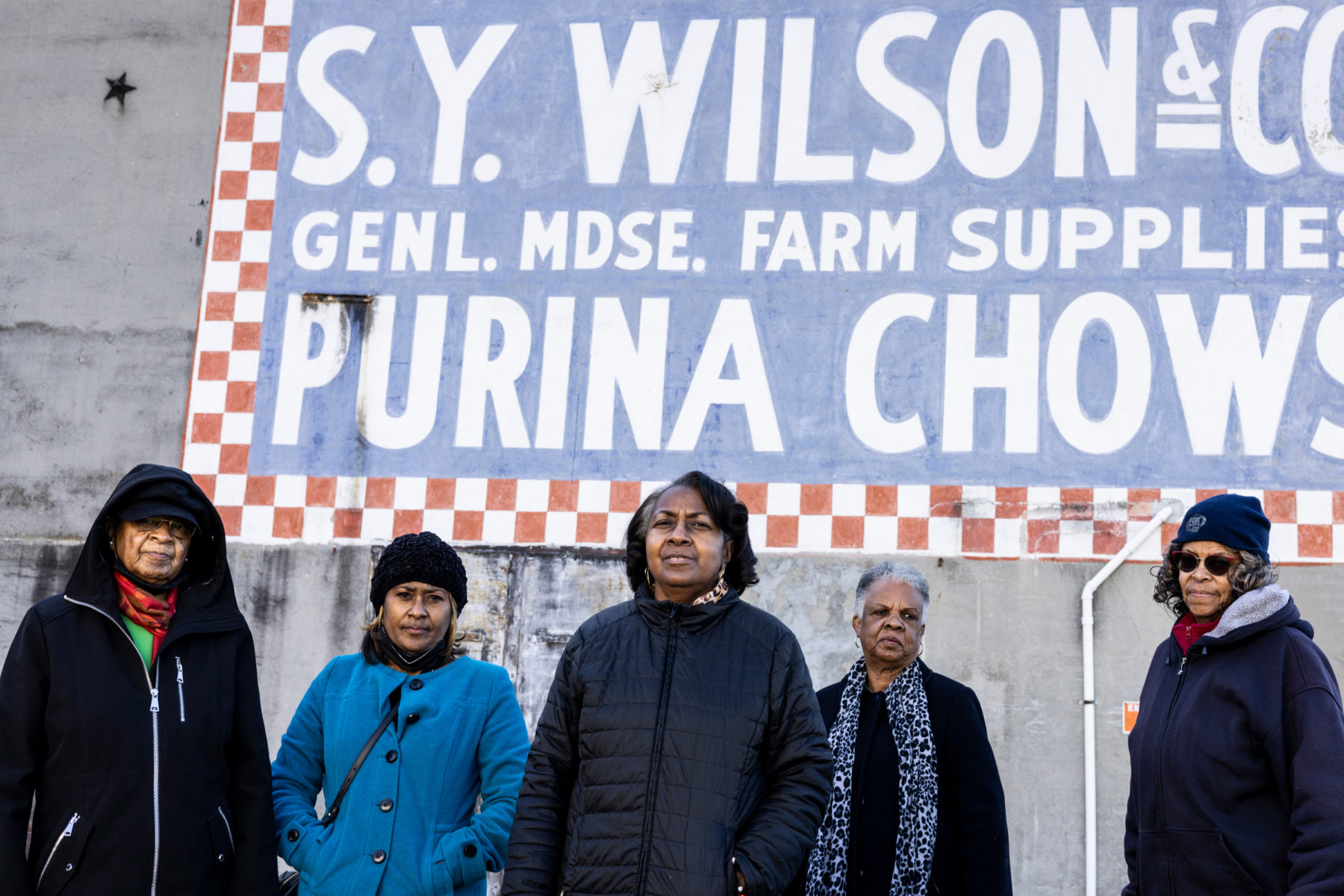
There’s not a lot of talking happening in Arlington, Tennessee.
That’s one of the first things Cynthia Myers tells me when she greets me in the middle of the small town square, about thirty minutes outside of Memphis. It’s a quaint and small plaza, with a Christmas tree and an old-fashioned red brick store hosting a steady stream of weekend shoppers. One thing that’s conspicuously absent from the courtyard, however, is any mention of the man who was shot to death and castrated right there, in broad daylight in 1939.
“It’s a taboo conversation,” Myers, 59 years old, told me wearily. “People don’t want to talk about it.”
Myers grew up with the story because the lynching victim, Jesse Lee Bond, was a cousin. And she was close to his brother, Charlie Morris, who spent years trying to bring the lynching to light. He died a few years ago, after successfully lobbying the state legislature to pass a cold case bill reopening investigations into unsolved murders from the civil rights era.
But Arlington remains silent on Bond’s lynching. There’s no sign in the town square marking the site of the killing or stone marking Bond’s grave. According to Memphis lynching memorial members I spoke with, some of the descendants of the alleged perpetrator still live in town but have not spoken up publicly about what happened. “Some of them are in this place of denial, the past is the past,” one Arlington resident told me.
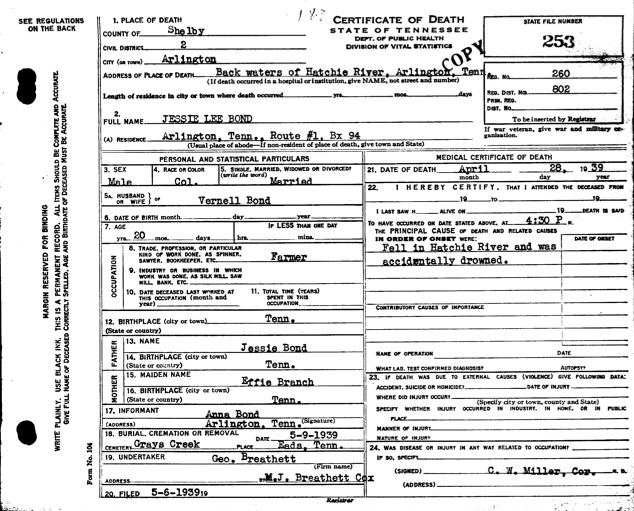
Jesse Lee Bond was a sharecropper who bought his seasonal planting supplies from Arlington’s general store, S.Y. Wilson & Company. The owners tracked the debt of farmers who bought their supplies on credit in a private notebook, and, according to some accounts, Bond was suspicious of how much they claimed he owed them. One day in April 1939, Bond asked for a receipt after buying something on credit, a request that was seen as out of the ordinary for a Black sharecropper in the Jim Crow South, and reportedly infuriated the white store owner when he found out. He ordered Bond to come back to the store, and his aunt accompanied him. When he arrived, the store owner and his employee started shooting, according to the Memphis lynching memorial group.
“They shot at him and shot him. He ran out to the outhouse. They riddled the outhouse,” Morris said Bond’s aunt later told him. “And when he staggered out of the outhouse, they threw him down and they castrated him and dragged him to the river.” County records reported the cause of his death as an “accidental drowning.” The store’s owner, Charles R. Wilson, and his employee were charged with first-degree murder but later acquitted by an all-white jury.
Charlie Morris was at school when he found out his brother had been murdered. “It affected me very much,” he recalled in an oral history recorded before he died. “My mother had three sons. And when she passed away, I was six. And the last thing that she said, on her deathbed, was ‘keep my boys together.’ And this was broken when they killed Jesse.”
On the 79th anniversary of Bond’s lynching, the Memphis lynching group hosted a memorial ceremony and vigil in the Arlington town square. But since then, efforts to install a memorial in the square or a marker on Bond’s grave have been unsuccessful. “Arlington is this little town with this nice cute square, and that’s the icon for the town,” Gordon Myers, a local Reverend, told me, over lunch in town. “There’s a lot of energy towards preserving this facade within the administration of the town and the politics and real estate development.” Placing a lynching memorial in the center of it all would complicate the image the town markets to itself and others.
But Myers wants to see just that. From her perspective, the town’s ongoing silence feels like an acceptance of the lynching itself. “It’s like they’re still supporting what happened. To not want to engage with it, deal with it, or even discuss it, she told me. “Even if you don’t apologize, just open up about it. That would make a difference. It would give some closure about what happened.”
On one of my last days in the South, I stopped by the town square in Oxford, Mississippi, with Tarrell and some members of the local lynching memorial initiative, the Lafayette County Community Remembrance Project.
The group was about half white, half Black, and mostly over the age of 50, although there were a few younger people there. They wanted to show me the memorial dedicated to the county’s seven lynching victims that was installed on September 17, 2021 in front of the county courthouse after a years-long, messy approval battle with the County Board of Supervisors.
The group included people with deep ties to the town and its violent history. 67-year-old Oxford native Effie Burt told me her grandfather, a sharecropper, left town after he was threatened with a lynching for refusing to work. “That could have been him on that sign,” she said, motioning to the marker. His sons fled to Missouri in the middle of the night to escape the specter of violence. “That destroyed my family,” Burt added. “I grew up without my uncles.”

A Confederate monument stands in front of Oxford’s town square in Mississippi. In September 2021, a local lynching memorial group installed a nearby marker remembering the county’s seven lynching victims, including William Steen.
As we were talking, I couldn’t help but fixate on the visuals of my surroundings. We stood next to the lynching memorial, at one edge of the town square, near the county courthouse. A stone’s throw away, an enormous Confederate statue loomed over the front of the square. Calls to remove it have been unsuccessful, so the statue now uneasily skirts the lynching memorial. It’s almost too perfect of a metaphor for America’s relationship with its past: the tensions of the current moment in the country’s historial reckoning carved in miniature, between these two memorials, on this town square.
As I reflected on the contrasting iconography, I thought of something Dominik, the German playwright, told me when I explained the fractured state of American memory politics. “To some extent, it’s not that bad,” he replied. “At least you have a fight. A fight about history and ideas and the future of the country.”
A clash is also a sign of life. Not a calcified, collectivized consensus on the past, but a living organism, being worked out right in front of you — on the Oxford square, or downtown Memphis, or in the minds of white Americans as the country spars over how to narrate the truest version of its history to the next generation.
“When you move the conversation from the larger historical systemic to the personal, I think that’s what people are afraid of,” Dr. William Horne, Arthur J. Ennis Postdoctoral Fellow at Villanova University, who has written on his family’s role in slavery, told me. “Sometimes I wonder — is the best we can do to have a systemic conversation about systemic wrongs?”
In Mississippi, Tarrell recently learned about a family in the area where Steen was lynched with the same last name as the white woman he allegedly had a relationship with. He told me hasn’t been able to get in touch yet, but he’d like to meet up. He’s not interested in blame. He just wants to get closer to understanding what happened on July 30, 1893, and why.
“I’m not trying to disgrace anyone,” he said. “I just want to know what happened. If I had the opportunity to talk to one of them, they might say something that could help me learn more about my ancestors. I’m just trying to find the truth. And have some closure for the family. That’s the only thing I want to do.”
The story you just read is a small piece of a complex and an ever-changing storyline that Coda covers relentlessly and with singular focus. But we can’t do it without your help. Show your support for journalism that stays on the story by becoming a member today. Coda Story is a 501(c)3 U.S. non-profit. Your contribution to Coda Story is tax deductible.






